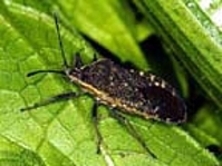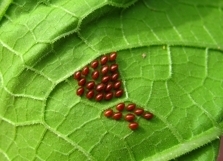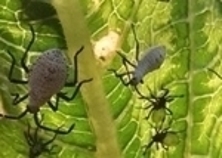Squash Bug
Anasa tristis
The squash bug, Anasa tristis, is a leaf-footed true bug in the family Coreidae, order Hemiptera. Leaf-footed bugs get their name from the flattened, leaf-like flare on the lower portion of the back legs or tibia.
Damage
Squash bugs are a major pest of cucurbits, particularly squash and pumpkins, and can severley weaken a plant as they feed with their long, sucking and piercing mouthparts. Squash bug feeding will appear as stippled areas after which leaves will yellow and dry out.
Life Cycle
Adults emerge in late spring and feed on leaves of developing squash plants although they are usually found on plant stems at the soil surface. The 3/4" long, flat, greyish-brown adults will mate and the female will lay eggs in groups on the undersides of the squash leaves. Egg-laying may occur over the period of a month. The copper-brown, football-shaped eggs hatch after about 10 days and the nymphs start feeding.


Over 33 days there are five nymph stages, called instars, starting at 1/10th of an inch in length long green nymphs that get darker and larger with each instar before adulthood. It’s this nymph feeding, mostly on the undersides of leaves, that causes the most economic damage. They are adults by August and continue to feed through the fall. They overwinter as adults in protected areas. There is only one generation per year in Connecticut although the life stages of the squash bug can overlap and you may find adults and nymphs present at the same time.


Management
- Begin scouting early for squash bug adults, especially if they have been an issue in the past.
- Use floating row covers until flowers are in bloom to keep adults from developing plants.
- Watering near the soil surface often brings the adults out where they can be hand-picked and dropped into soapy water.
- Turn over leaves to find eggs or nymphs.
- Remove and crush any eggs or tear out and destroy that piece of the leaf.
- The sticky side of duct or packing tape can also be used to remove eggs.
- Crush nymphs.
- Horticultural oil, insecticidal soap, and Neem oil are low-toxicity insecticides that can be sprayed on nymphs early-morning or evening to minimize the effect on pollinators.
- Remove all plant debris during and at the end of the season.
Despite good cultural practices, pests and diseases at times may appear. Chemical control should be used only after all other methods have failed.
For pesticide information or other questions please call toll free: 877-486-6271.
UConn Home and Garden Education Center, 2018
Issued in furtherance of Cooperative Extension work, Acts of May 8 and June 30, 1914, in cooperation with the U.S. Department of Agriculture, the Dean of the College, Cooperative Extension System, University of Connecticut, Storrs. The Connecticut Cooperative Extension System is an equal opportunity employer and program provider. To file a complaint of discrimination, write USDA, Director, Office of Civil Rights, Room 326-W, Whitten Building, Stop Code 9410, 1400 Independence Avenue, SW, Washington, DC 20250-9410 or call (202) 720-5964.